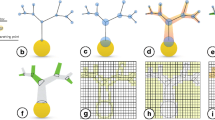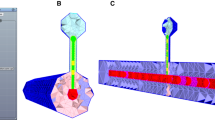Abstract
Generating realistic and complex computational domains for numerical simulations is often a challenging task. In neuroscientific research, more and more one-dimensional morphology data is becoming publicly available through databases. This data, however, only contains point and diameter information not suitable for detailed three-dimensional simulations. In this paper, we present a novel framework, AnaMorph, that automatically generates water-tight surface meshes from one-dimensional point-diameter files. These surface triangulations can be used to simulate the electrical and biochemical behavior of the underlying cell. In addition to morphology generation, AnaMorph also performs quality control of the semi-automatically reconstructed cells coming from anatomical reconstructions. This toolset allows an extension from the classical dimension-reduced modeling and simulation of cellular processes to a full three-dimensional and morphology-including method, leading to novel structure-function interplay studies in the medical field. The developed numerical methods can further be employed in other areas where complex geometries are an essential component of numerical simulations.












Similar content being viewed by others
References
Ascoli, G.A. (2006). Mobilizing the base of neuroscience data: the case of neuronal morphologies. Nature Reviews Neuroscience, 7, 318–324. doi:10.1038/nrn1885.
Barnhill, R., Farin, G., Jordan, M., & Piper, B. (1987). Surface/surface intersection. Computer Aided Geometric Design, 4(1), 3–16. doi:10.1016/0167-8396(87)90020-3. http://www.sciencedirect.com/science/article/pii/0167839687900203.
Bartoň, M., & Jüttler, B. (2007a). Computing roots of polynomials by quadratic clipping. Computer Aided Geometric Design, 24(3), 125–141. doi:10.1016/j.cagd.2007.01.003.
Bartoň, M., & Jüttler, B. (2007b). Computing roots of systems of polynomials by linear clipping. Technical Report 2007-18, SFB F013 Technical Report.
Biermann, H., Kristjansson, D., & Zorin, D. (2001). Approximate boolean operations on free-form solids, Proceedings of the 28th annual conference on computer graphics and interactive techniques, ACM, New York, NY, USA, SIGGRAPH ’01. doi:10.1145/383259.383280 (pp. 185–194).
Borg-Graham, L.J. (1999). Models of cortical circuits, Springer US, Boston, MA, chap Interpretations of data and mechanisms for hippocampal pyramidal cell models (pp 19–138). doi:10.1007/978-1-4615-4903-1_2.
Breit, M., Stepniewski, M., Grein, S., Gottmann, P., Reinhardt, L., & Queisser, G. (2016). Anatomically detailed and large-scale simulations studying synapse loss and synchrony using neuroBox. Frontiers in Neuroanatomy, 10, 8. doi:10.3389/fnana.2016.00008.
Brito, J., Mata, S., Bayona, S., Pastor, L., DeFelipe, J., & Benavides Piccione, R. (2013). Neuronize: a tool for building realistic neuronal cell morphologies. Frontiers in Neuroanatomy, 7, 15. doi:10.3389/fnana.2013.00015.
Cignoni, P., Callieri, M., Corsini, M., Dellepiane, M., Ganovelli, F., & Ranzuglia, G. Scarano, V, Chiara, R.D., & Erra, U. (Eds.) (2008). MeshLab: an open-source mesh processing tool.
Coombs, J., van der List, D., Wang, G.Y., & Chalupa, L. (2006). Morphological properties of mouse retinal ganglion cells. Neuroscience, 140(1), 123–136. doi:10.1016/j.neuroscience.2006.02.079.
Do Carmo, M.P., & Do Carmo, M.P. (1976). Differential geometry of curves and surfaces Vol. 2. Englewood Cliffs: Prentice-Hall.
Elsheikh, A.H., & Elsheikh, M. (2014). A reliable triangular mesh intersection algorithm and its application in geological modelling. Engineering with Computers, 30(1), 143–157. doi:10.1007/s00366-012-0297-3.
Farouki, R.T. (2012). The Bernstein polynomial basis: a centennial retrospective. Computer Aided Geometric Design, 29(6), 379–419. doi:10.1016/j.cagd.2012.03.001.
Farouki, R.T., & Goodman, T.N.T. (1996). On the optimal stability of the Bernstein basis. Mathematics of Computation, 65, 1553– 1566.
Farouki, R.T., & Rajan, V.T. (1988). Algorithms for polynomials in Bernstein form. Computer Aided Geometric Design, 5(1), 1–26. doi:10.1016/0167-8396(88)90016-7.
Floater, M.S., & Surazhsky, T. (2006). Parameterization for curve interpolation. Studies in Computational Mathematics, 12, 39–54.
Garland, M., & Heckbert, P.S. (1997). Surface simplification using quadric error metrics, Proceedings of the 24th annual conference on computer graphics and interactive techniques, SIGGRAPH ’97. doi:10.1145/258734.258849 (pp. 209–216). New York, NY, USA: ACM Press/Addison-Wesley Publishing Co.
Grein, S., Stepniewski, M., Reiter, S., Knodel, M.M., & Queisser, G. (2014). 1D-3D hybrid modelling – from multi-compartment models to full resolution models in space and time. Frontiers in Neuroinformatics, 8(68), 1–13. doi:10.3389/fninf.2014.00068. http://www.frontiersin.org/neuroinformatics/10.3389/fninf.2014.00068/abstract.
Greiner, H. (1991). A survey on univariate data interpolation and approximation by splines of given shape. Mathematical and Computer Modelling, 15(10), 97–106. doi:10.1016/0895-7177(91)90094-N. http://www.sciencedirect.com/science/article/pii/089571779190094N.
Groh, A., Meyer, H.S., Schmidt, E.F., Heintz, N., Sakmann, B., & Krieger, P. (2009). Cell-type specific properties of pyramidal neurons in neocortex underlying a layout that is modifiable depending on the cortical area. Cerebral Cortex, 20(4), 826. doi:10.1093/cercor/bhp152.
Hines, M.L., & Carnevale, N.T. (1997). The NEURON simulation environment. Neural computation, 9(6), 1179–1209.
Ishizuka, N., Cowan, W.M., & Amaral, D.G. (1995). A quantitative analysis of the dendritic organization of pyramidal cells in the rat hippocampus. The Journal of Comparative Neurology, 362(1), 17–45. doi:10.1002/cne.903620103.
Jüttler, B. (1998). The dual basis functions for the Bernstein polynomials. Advances in Computational Mathematics, 8(1998), S345–352. http://tubiblio.ulb.tu-darmstadt.de/9526/.
Jüttler, B., & Moore, B. (2011). A quadratic clipping step with superquadratic convergence for bivariate polynomial systems. Mathematics in Computer Science, 5(2), 223–235. doi:10.1007/s11786-011-0091-4.
Lasserre, S., Hernando, J., Hill, S., Schuermann, F., de Miguel Anasagasti, P., Jaoude, G.A., & Markram, H. (2012). A neuron membrane mesh representation for visualization of electrophysiological simulations. IEEE Transactions on Visualization and Computer Graphics, 18(2), 214–227. doi:10.1109/TVCG.2011.55.
Levien, R., & Séquin, C.H. (2009). Interpolating splines: which is the fairest of them all? Computer-Aided Design and Applications, 6(1), 91–102.
Liu, L., Zhang, L., Lin, B., & Wang, G. (2009). Fast approach for computing roots of polynomials using cubic clipping. Computer Aided Geometric Design, 26(5), 547–559. doi:10.1016/j.cagd.2009.02.003.
Lo, S.H. (1995). Automatic mesh generation over intersecting surfaces. International Journal for Numerical Methods in Engineering, 38(6), 943–954. doi:10.1002/nme.1620380605.
Lorensen, W.E., & Cline, H.E. (1987). Marching cubes: a high resolution 3d surface construction algorithm. SIGGRAPH Comput Graph, 21(4), 163–169. doi:10.1145/37402.37422.
Maekawa, T., Patrikalakis, N.M., Sakkalis, T., & Yu, G. (1998). Analysis and applications of pipe surfaces. Computer Aided Geometric Design, 15(5), 437–458.
McDonald, C., Eppolito, A., Brielmaier, J., Smith, L., Bergstrom, H., Lawhead, M., & Smith, R. (2007). Evidence for elevated nicotine-induced structural plasticity in nucleus accumbens of adolescent rats. Brain Research, 1151, 211–218. doi:10.1016/j.brainres.2007.03.019. http://www.sciencedirect.com/science/article/pii/S0006899307006051.
McDougal, R.A., Hines, M.L., & Lytton, W.W. (2013). Water-tight membranes from neuronal morphology files. Journal of Neuroscience Methods, 220(2), 167–178. doi:10.1016/j.jneumeth.2013.09.011. http://www.ncbi.nlm.nih.gov/pmc/articles/PMC4197804/.
Moerschel, K. (2013). AnaMorph: a framework for geometric modelling consistency analysis and surface mesh generation of anatomically reconstructed neuron morphologies. Diploma thesis, Goethe-Universität Frankfurt am Main.
Nielson, G.M. (2004). Dual marching cubes, Proceedings of the conference on visualization ’04, IEEE Computer Society, Washington, DC, USA, VIS ’04. doi:10.1109/VISUAL.2004.28 (pp. 489–496).
Patrikalakis, N.M., & Maekawa, T. (2002). Shape interrogation for computer aided design and manufacturing. Springer.
Queisser, G., Wiegert, S., & Bading, H. (2011). Structural dynamics of the cell nucleus: basis for morphology modulation of nuclear calcium signaling and gene transcription. Nucleus, 2(2), 98–104.
Reiter, S. (2012). ProMesh – meshing of unstructured grids in 1, 2, and 3 dimensions. http://promesh3d.com.
Reiter, S. (2014). Effiziente Algorithmen und Datenstrukturen für die Realisierung von adaptiven hierarchischen Gittern auf massiv parallelen Systemen. PhD thesis, Universität Frankfurt am Main.
Rossignac, J.R. (1985). Blending and offsetting solid models (cad/cam, computational geometry, representations, curves, surfaces, approximation). Phd Thesis, The University of Rochester, aAI8528560.
Schroeder, W., Martin, K.M., & Lorensen, W.E. (2006). The visualization toolkit (4th ed.). Kitware.
Schulz, C. (2009). Bézier clipping is quadratically convergent. Computer Aided Geometric Design, 26(1), 61–74. doi:10.1016/j.cagd.2007.12.006. http://www.sciencedirect.com/science/article/pii/S0167839607001434.
Sederberg, T., & Nishita, T. (1990). Curve intersection using Bézier clipping. Computer-Aided Design, 22 (9), 538–549. doi:10.1016/0010-4485(90)90039-F. http://www.sciencedirect.com/science/article/pii/001044859090039F.
Shemer, I., Brinne, B., Tegnér, J., & Grillner, S. (2008). Electrotonic signals along intracellular membranes may interconnect dendritic spines and nucleus. PLOS Computational Biology, 4(3), 1–19. doi:10.1371/journal.pcbi.1000036.
Si, H. (2015). TetGen, a Delaunay-based quality tetrahedral mesh generator. ACM Transactions on Mathematical Software, 41(2), 11:1–11:36. doi:10.1145/2629697.
The CGAL Project (2016). CGAL User and reference manual. http://doc.cgal.org/4.9/Manual/packages.html.
Vogel, A., Reiter, S., Rupp, M., Nägel, A., & Wittum, G. (2013). UG 4: a novel flexible software system for simulating PDE based models on high performance computers. Computing and Visualization in Science, 16(4), 165–179. doi:10.1007/s00791-014-0232-9.
Vollmer, J., Mencl, R., & Müller, H. (1999). Improved laplacian smoothing of noisy surface meshes, Computer graphics forum (pp. 131–138).
Vuksic, M., Del Turco, D., Bas Orth, C., Burbach, G.J., Feng, G., Müller, C.M., Schwarzacher, S.W., & Deller, T. (2008). 3D-Reconstruction and functional properties of GFP-positive and GFP-negative granule cells in the fascia dentata of the thy1-GFP mouse. Hippocampus, 18(4), 364–375. doi:10.1002/hipo.20398 10.1002/hipo.20398.
Wittmann, M., Queisser, G., Eder, A., Wiegert, J., Bengtson, C., Hellwig, A., Wittum, G., & Bading, H. (2009). Synaptic activity induces dramatic changes in the geometry of the cell nucleus: interplay between nuclear structure, histone h3 phosphorylation, and nuclear calcium signaling. The Journal of Neuroscience, 29(47), 14,687–14,700.
Author information
Authors and Affiliations
Corresponding author
Rights and permissions
About this article
Cite this article
Mörschel, K., Breit, M. & Queisser, G. Generating Neuron Geometries for Detailed Three-Dimensional Simulations Using AnaMorph. Neuroinform 15, 247–269 (2017). https://doi.org/10.1007/s12021-017-9329-x
Published:
Issue Date:
DOI: https://doi.org/10.1007/s12021-017-9329-x




